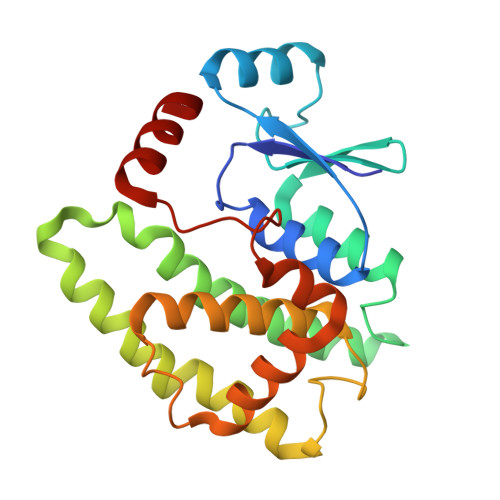Crystal structure of human glutathione S-transferase A3-3 and mechanistic implications for its high steroid isomerase activity.
Gu, Y., Guo, J., Pal, A., Pan, S.S., Zimniak, P., Singh, S.V., Ji, X.(2004) Biochemistry 43: 15673-15679
- PubMed: 15595823
- DOI: https://doi.org/10.1021/bi048757g
- Primary Citation of Related Structures:
1TDI - PubMed Abstract:
The crystal structure of human class alpha glutathione (GSH) S-transferase A3-3 (hGSTA3-3) in complex with GSH was determined at 2.4 A. Despite considerable amino acid sequence identity with other human class alpha GSTs (e.g., hGSTA1-1), hGSTA3-3 is unique due to its exceptionally high steroid double bond isomerase activity for the transformation of Delta(5)-androstene-3,17-dione (Delta(5)-AD) to Delta(4)-androstene-3,17-dione. A comparative analysis of the active centers of hGSTA1-1 and hGSTA3-3 reveals that residues in positions 12 and 208 may contribute to their disparate isomerase activity toward Delta(5)-AD. Substitution of these two residues of hGSTA3-3 with the corresponding residues in hGSTA1-1 followed by kinetic characterization of the wild-type and the mutant enzymes supported this prediction. On the basis of our model of the hGSTA3-3.GSH.Delta(5)-AD ternary complex and available biochemical data, we propose that the thiolate group of deprotonated GSH (GS(-)) serves as a base to initiate the reaction by accepting a proton from the steroid and the nonionized hydroxyl group of catalytic residue Y9 (HO-Y9) functions as part of a proton-conducting wire to transfer a proton back to the steroid. Residue R15 may function to stabilize the deprotonated thiolate group of GSH (GS(-)), and a GSH-bound water molecule may donate a hydrogen bond to the 3-keto group of Delta(5)-AD and thus help the thiolate of GS(-) to initiate the proton transfer and the subsequent stabilization of the reaction intermediate.
Organizational Affiliation:
Macromolecular Crystallography Laboratory, National Cancer Institute, Frederick, Maryland 21702, USA.















